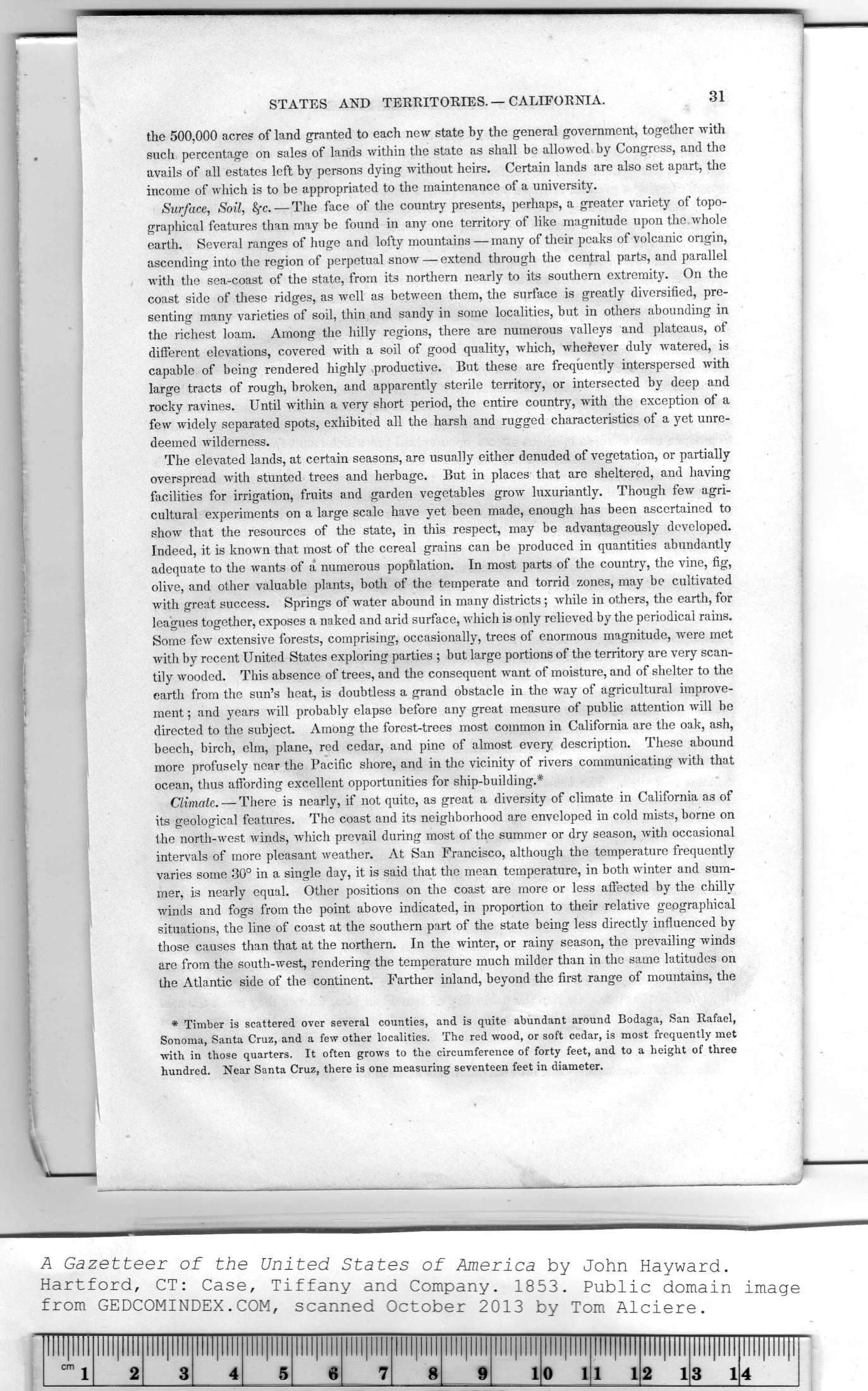|
|
Note: Ctrl and + increases the font size of the text below, Ctrl and - decreases it, and Ctrl and 0 resets it to default size.
STATES AND TERRITORIES. — CALIFORNIA. 31
the 500,000 acres of land granted to each new state by the general government, together with
such percentage on sales of lands within the state as shall be allowed by Congress, and the
avails of all estates left by persons dying without heirs. Certain lands are also set apart, the
income of which is to be appropriated to the maintenance of a university.
Surface, Soil, fyc. — The face of the country presents, perhaps, a greater variety of topo-
graphical features than may be found in any one territory of like magnitude upon the whole
earth. Several ranges of huge and lofty mountains — many of their peaks of volcanic origin,
ascending into the region of perpetual snow — extend through the central parts, and parallel
with the sea-coast of the state, from its northern nearly to its southern extremity. On the
coast side of these ridges, as well as between them, the surface is greatly diversified, pre-
senting many varieties of soil, thin and sandy in some localities, but in others abounding in
the richest loam. Among the hilly regions, there are numerous valleys and plateaus, of
different elevations, covered with a soil of good quality, which, wherever duly watered, is
capable of being rendered highly .productive. But these are frequently interspersed with
large tracts of rough, broken, and apparently sterile territory, or intersected by deep and
rocky ravines. Until within a very short period, the entire country, with the exception of a
few widely separated spots, exhibited all the harsh and rugged characteristics of a yet unre-
deemed wilderness.
The elevated lands, at certain seasons, are usually either denuded of vegetation, or partially
overspread with stunted trees and herbage. But in places that are sheltered, and having
facilities for irrigation, fruits and garden vegetables grow luxuriantly. Though few agri-
cultural experiments on a large scale have yet been made, enough has been ascertained to
show that the resources of the state, in this respect, may be advantageously developed.
Indeed, it is known that most of the cereal grains can be produced in quantities abundantly
adequate to the wants of a numerous population. In most parts of the country, the vine, fig,
olive, and other valuable plants, both of the temperate and torrid zones, may be cultivated
with great success. Springs of water abound in many districts ; while in others, the earth, for
leagues together, exposes a naked and arid surface, which is only relieved by the periodical rains.
Some few extensive forests, comprising, occasionally, trees of enormous magnitude, were met
with by recent United States exploring parties ; but large portions of the territory are very scan-
tily wooded. This absence of trees, and the consequent want of moisture, and of shelter to the
earth from the sun's heat, is doubtless a grand obstacle in the way of agricultural improve-
ment ; and years will probably elapse before any great measure of public attention will be
directed to the subject. Among the forest-trees most common in California are the oak, ash,
beech, birch, elm, plane, red cedar, and pine of almost every description. These abound
more profusely near the Pacific shore, and in the vicinity of rivers communicating with that
ocean, thus affording excellent opportunities for ship-building.#
Climate. — There is nearly, if not quite, as great a diversity of climate in California as of
its geological features. The coast and its neighborhood are enveloped in cold mists, borne on
the north-west winds, which prevail during most of the summer or dry season, with occasional
intervals of more pleasant weather. At San Francisco, although the temperature frequently
varies some 30° in a single day, it is said that the mean temperature, in both winter and sum-
mer, is nearly equal. Other positions on the coast are more or less affected by the chilly
winds and fogs from the point above indicated, in proportion to their relative geographical
situations, the line of coast at the southern part of the state being less directly influenced by
those causes than that at the northern. In the winter, or rainy season, the prevailing winds
are from the south-west, rendering the temperature much milder than in the same latitudes on
the Atlantic side of the continent. Farther inland, beyond the first range of mountains, the
* Timber is scattered over several counties, and is quite abundant around Bodaga, San Rafael,
Sonoma, Santa Cruz, and a few other localities. The red wood, or soft cedar, is most frequently met
with in those quarters. It often grows to the circumference of forty feet, and to a height of three
hundred. Near Santa Cruz, there is one measuring seventeen feet in diameter.
A Gazetteer of the United States of America by John Hayward.
Hartford, CT: Case, Tiffany and Company. 1853. Public domain image
|
